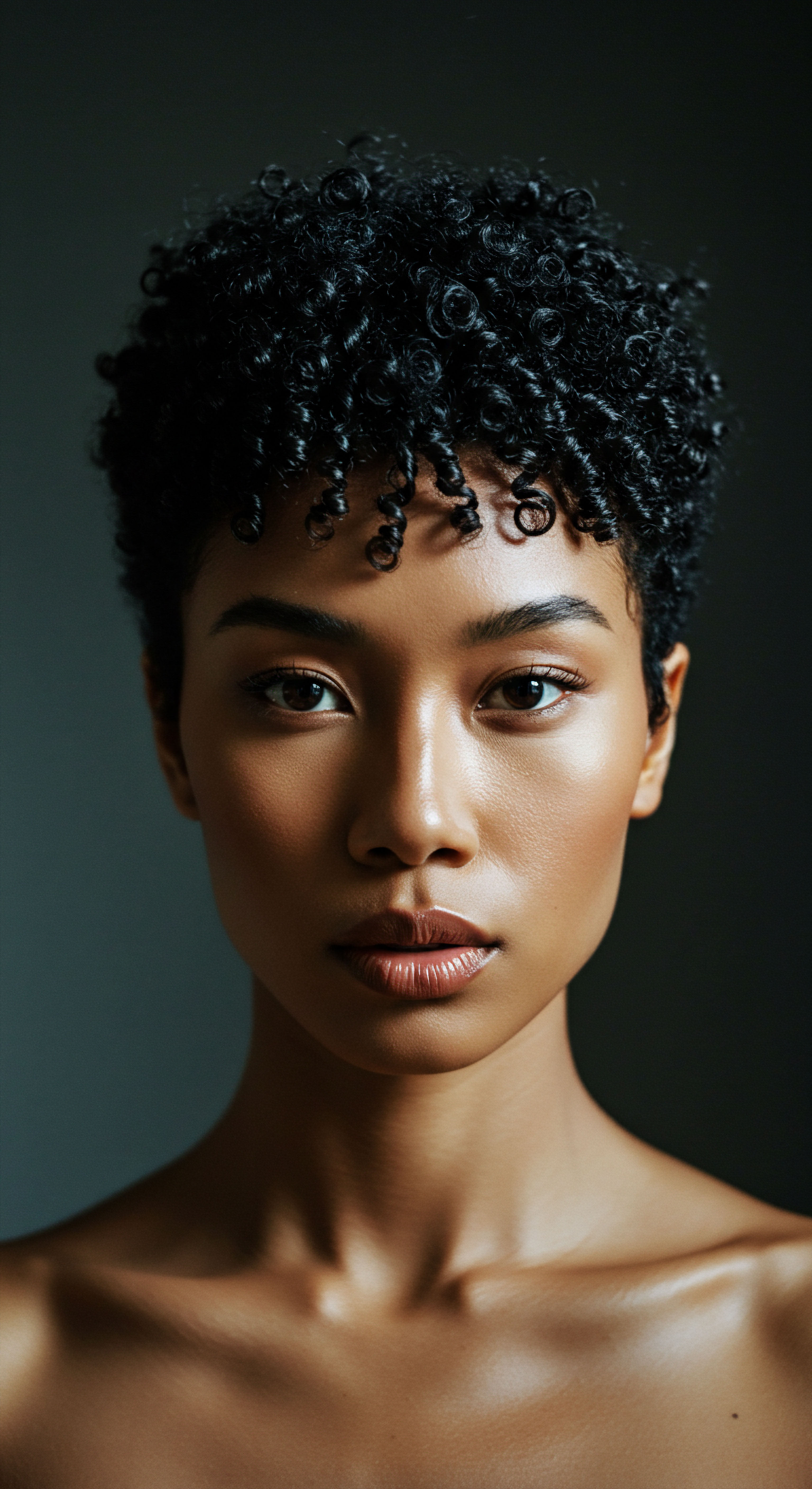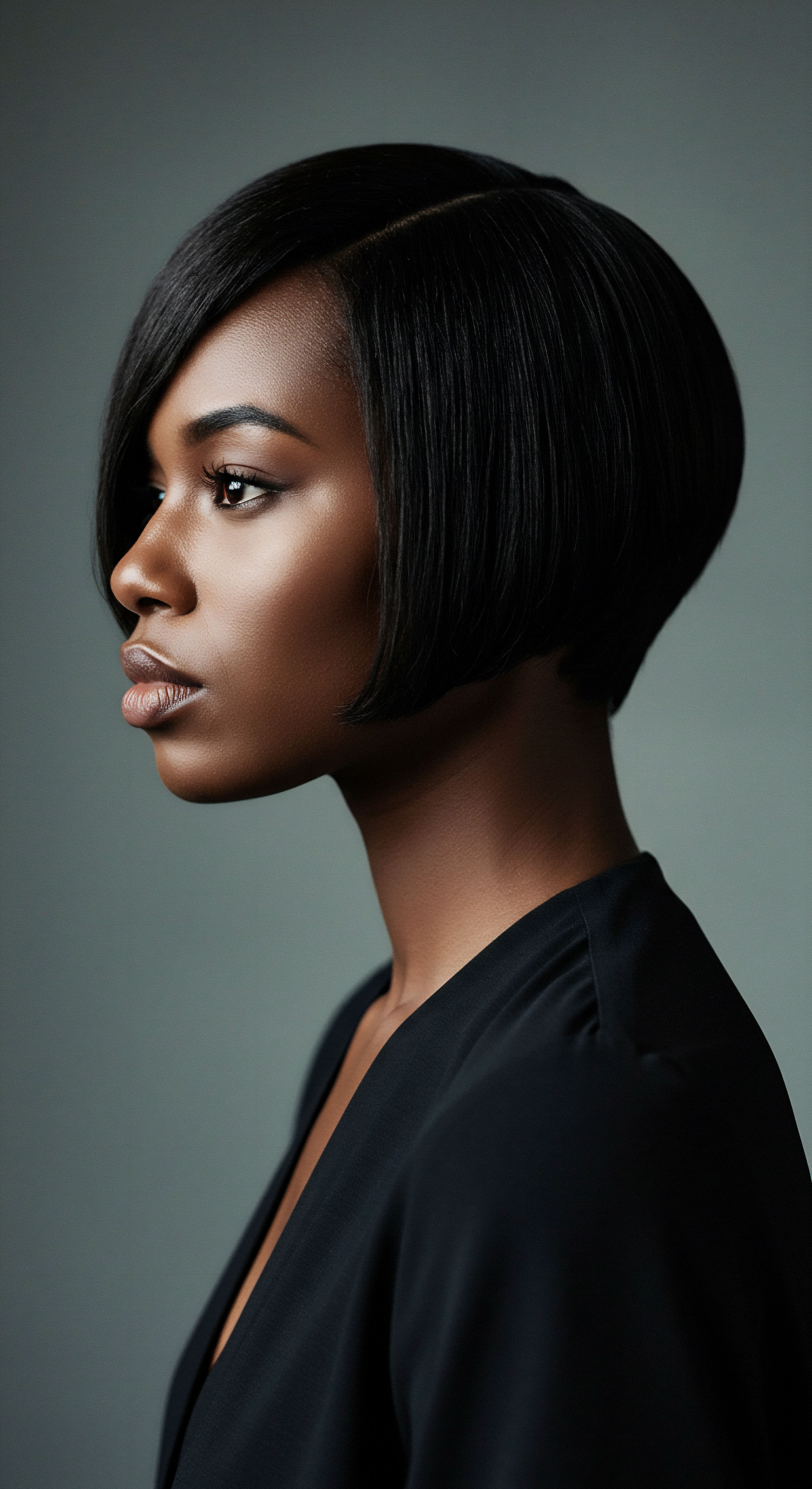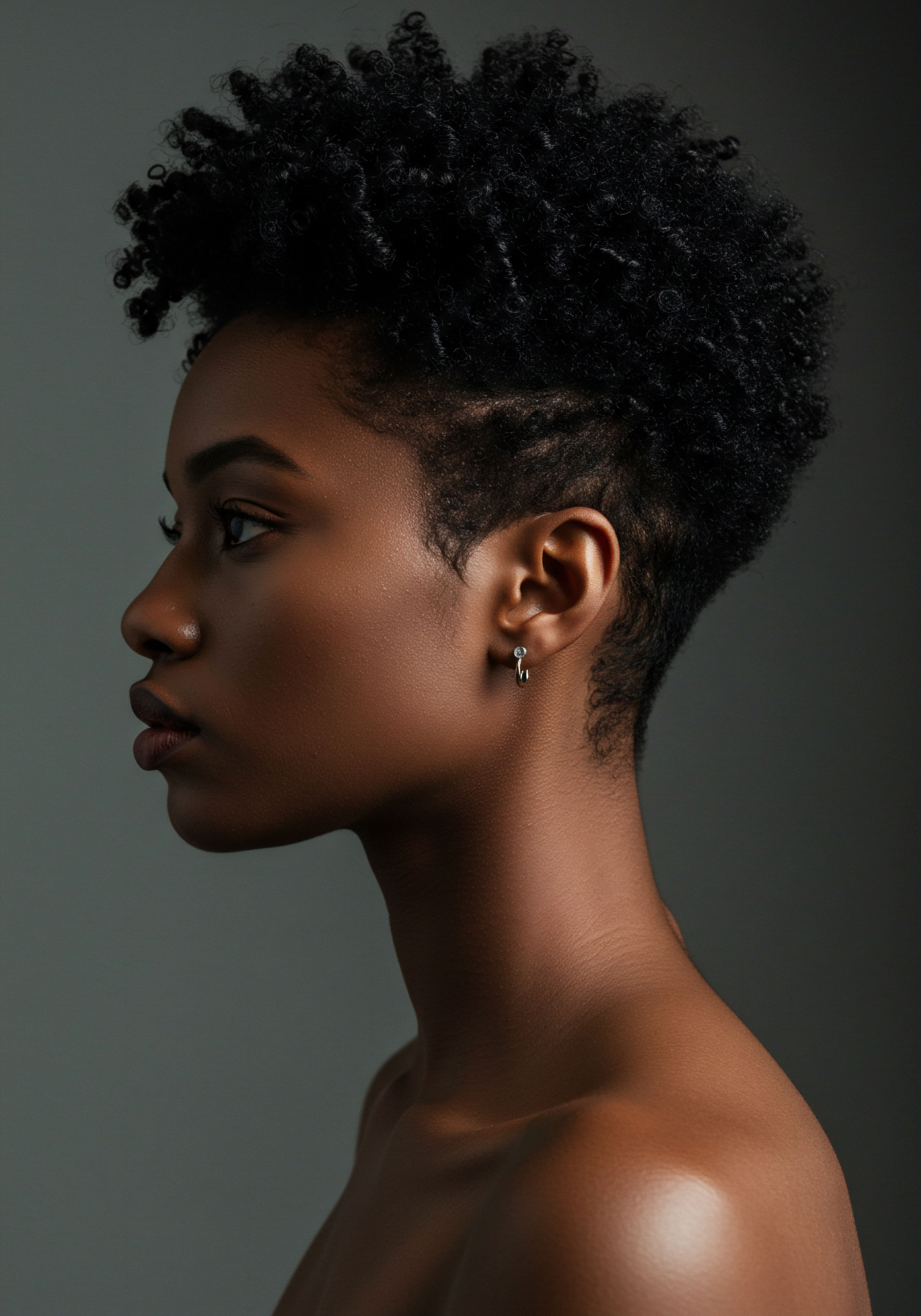
Roots
The quiet hum of life, the rhythmic pulse of community, often manifests in ways subtle yet profound. For pre-colonial African societies, this deep resonance was frequently found within the delicate, resilient strands of hair. Consider for a moment how a single strand, seemingly small, holds a universe of genetic information. Extend that thought to a head of hair, then to a community gathered, and suddenly, the picture clarifies ❉ hair was not merely a crown of individual beauty.
Instead, it functioned as a living, breathing chronicle of social standing, spiritual connection, and collective identity. The act of tending to hair, far from a solitary pursuit, became a powerful conduit for human connection, a practice where fingers interlaced not only hair but also lives, stories, and shared destinies.

Hair as a Social Ledger
In these vibrant societies, a person’s hairstyle could communicate volumes without a single word being spoken. It served as an intricate, visible lexicon, immediately conveying details about one’s place within the community. Imagine meeting someone new; their carefully sculpted coiffure might tell you of their marital status, perhaps indicating they were a young woman ready for marriage, or a revered elder whose wisdom had accumulated with each passing season. It could signal their age grade, a particular stage of life’s journey, or even their specific ethnic affiliation, a marker of ancestral lineage and shared heritage.
Beyond these personal identifiers, hair often reflected a person’s economic standing or their role within the societal hierarchy. A leader might wear a distinct, elaborate style, signifying authority and respect, while a healer’s coiffure could hint at their spiritual duties. This visual language was universally understood, creating an immediate, non-verbal dialogue that strengthened communal bonds by clarifying roles and relationships within the social fabric.
Hair served as a visual language, conveying social standing, age, and ethnic identity within pre-colonial African communities.
The symbolic value of hair extended beyond simple identification. It was often imbued with spiritual significance, considered the most elevated part of the body, closest to the divine. This belief positioned hair as a conduit for spiritual energy, a physical connection to the ancestors and the cosmos.
The care of hair, therefore, was not merely a hygienic practice; it was a sacred ritual, an offering, a means of aligning oneself with spiritual forces. This collective reverence for hair deepened the communal sense of shared spirituality and purpose, reminding each individual of their place within a larger, interconnected spiritual world.

The Science of Shared Strands
The physical properties of textured hair, with its unique coil and curl patterns, lent themselves naturally to elaborate styling that demanded time and communal effort. Unlike straight hair, which might be brushed and left to its own devices, many traditional African styles, such as intricate braids, twists, and locs, required hours, sometimes even days, to complete. This inherent characteristic of textured hair meant that its care was rarely a solitary endeavor. Instead, it necessitated a gathering, a communal assembly where hands worked together, fingers deftly maneuvering strands into complex designs.
- Coil Patterns ❉ The natural inclination of textured hair to form coils and curls allowed for a vast array of protective and decorative styles, each requiring patient, skilled hands.
- Time Investment ❉ Many traditional styles demanded significant time, turning hair care sessions into extended periods of social interaction and shared activity.
- Skill Transmission ❉ The complexity of these styles ensured that styling knowledge and techniques were passed down through generations, often from elder women to younger ones, preserving cultural practices.
The very structure of the hair itself, therefore, mandated a collective approach to its care. This physical reality became a powerful catalyst for social interaction, transforming what might otherwise be a mundane task into a vibrant communal activity. It was within these shared spaces that bonds were not simply reinforced but actively sculpted, much like the hair itself.

Ritual
Stepping from the foundational understanding of hair’s symbolic weight, we now consider the active engagement, the living, breathing practices that truly animated communal bonds. These were not just chores; they were ceremonies of connection, rhythmic movements that synchronized hands and hearts. The process of hair care in pre-colonial African societies transcended the superficial, becoming a profound, applied wisdom, a shared language spoken through touch and presence. It was in these daily or periodic gatherings that the essence of community found its tangible expression, a gentle guide for how to truly belong.

Hands That Bind
The actual process of communal hair care involved a beautiful dance of hands and heads. Children would sit patiently between the knees of their mothers, aunts, or grandmothers, feeling the gentle tug and pull as fingers worked magic upon their crowns. Young women would gather in circles, braiding each other’s hair, their laughter and conversations filling the air. Elders, with their accumulated wisdom, would oversee these sessions, offering guidance, sharing stories, and imparting techniques passed down through countless generations.
This was a physical intimacy, a closeness that built trust and affection. The act of one person tending to another’s hair required vulnerability and surrender on the part of the one being styled, and patience and care from the stylist. This reciprocal relationship, built on gentle touch and shared focus, deepened personal connections within families and across broader community groups.
The tangible tools used in these rituals were often simple yet imbued with meaning. Combs carved from wood, natural oils extracted from local plants, and adornments crafted from shells, beads, or natural fibers were all part of the process. The preparation of these materials, too, could be a communal task, further extending the moments of shared activity.

Whispers of Wisdom
Beyond the physical act of styling, these hair care sessions served as vital informal educational spaces. As fingers moved, so too did knowledge. Oral traditions, histories, moral lessons, and practical life skills were exchanged. Children learned about their lineage and cultural norms, absorbing wisdom through the stories told by their elders.
Young women shared experiences, advice on courtship, marriage, and child-rearing. It was a dynamic exchange, where the wisdom of the past met the concerns of the present, ensuring the continuity of cultural values. The quiet focus required for intricate braiding allowed for deep, meaningful conversations to unfold, conversations that might not occur in more formal settings. This consistent, intergenerational dialogue strengthened the collective memory and identity of the community.
Hair care sessions served as vibrant informal schools, transmitting oral traditions, life skills, and cultural norms across generations.
Consider the rhythm of these sessions ❉ the steady parting of hair, the precise movements of fingers, the quiet murmurs of conversation, occasionally punctuated by a shared joke or a burst of song. This rhythm created a calming, almost meditative environment, conducive to open communication and emotional release. It was a safe space where worries could be voiced, joys celebrated, and support offered without judgment. The shared vulnerability of sitting for hours, trusting another with one’s appearance, built a foundation of psychological comfort and belonging.

The Rhythmic Pace of Connection
The duration of these hair care rituals played a significant role in their bonding capacity. Unlike quick modern routines, these were unhurried affairs, allowing for deep, sustained interaction. A single elaborate hairstyle might take an entire day, or even several days, requiring multiple individuals to contribute their time and skill. This collective investment of time symbolized the value placed on both the individual being groomed and the communal ties themselves.
It was a tangible demonstration of care and dedication, a commitment to each other’s well-being and social presentation. The patience cultivated during these long sessions mirrored the patience required for healthy community living, reinforcing the understanding that meaningful relationships require sustained effort and shared presence.
The communal nature of these practices also fostered a sense of collective responsibility. Each member played a part, whether by styling, preparing materials, or simply offering companionship. This collaborative effort reinforced the idea that individual beauty was a collective achievement, a reflection of the community’s shared artistry and mutual support.
| Aspect Physical Touch |
| Impact on Bonds Builds trust, affection, and intimacy. |
| Aspect Oral Tradition |
| Impact on Bonds Transmits cultural knowledge, history, and moral lessons. |
| Aspect Shared Time |
| Impact on Bonds Cultivates patience, demonstrates mutual commitment. |
| Aspect Collective Effort |
| Impact on Bonds Reinforces collective responsibility and shared achievement. |

Relay
We now turn our gaze to the deepest currents of communal hair care, where the physical act of grooming transformed into a profound mechanism for societal cohesion and cultural preservation. This exploration moves beyond the immediate sensory experience, inviting a deeper consideration of the intricate interplay between science, culture, and the subtle forces that bind a collective. How did these practices not merely facilitate pleasant interactions but actively strengthen the very foundations of pre-colonial African societies? The answer lies in their capacity to serve as conduits for social capital, emotional support, and the dynamic maintenance of identity across generations.

The Makai Legacy ❉ A Study in Shared Identity
To truly appreciate the depth of these practices, consider the example of the Makai Hairstyle of the Elmina people in Ghana. Research indicates that this specific style, with roots tracing back to approximately 1300 CE, held immense sociocultural significance. It was not merely an aesthetic choice; it was deeply intertwined with the annual Bakatue festival, a central community celebration, and with traditional religious beliefs, including the reverence for the river god Nana Benya. The very existence and continuation of the Makai hairstyle were dependent on communal participation and the transmission of specialized knowledge.
Indigenous hairstylists, some with decades of experience, continue to practice and preserve these intricate techniques, a testament to the enduring power of shared cultural artistry. This continuity underscores how communal hair care acted as a living museum, preserving and animating a people’s history and spiritual convictions through shared action.
This example challenges the simplistic view of hair styling as a superficial activity. Instead, it reveals a system where collective memory and identity were quite literally styled into being. The long history of the Makai style, its connection to core community events, and the generational relay of its creation, demonstrate a powerful mechanism for social reproduction and solidarity. It was a tangible expression of what it meant to be Elmina, a visual declaration of belonging and shared heritage.

Beyond Adornment ❉ Social Capital in Every Braid
Communal hair care sessions were powerful engines for building social capital. This term, in its simplest sense, refers to the networks of relationships among people who live and work in a particular society, enabling that society to function effectively. In the context of pre-colonial African societies, these grooming gatherings were prime settings for the generation of such capital.
Consider the practical benefits:
- Reciprocal Support ❉ Individuals provided care for one another without expectation of immediate material payment, establishing a system of mutual aid. This could extend to other aspects of life, knowing that those who shared their time for hair care would also offer support in times of need.
- Conflict Mitigation ❉ Spending extended periods in close proximity, engaged in a shared, calming activity, provided opportunities for individuals to discuss grievances, mediate disputes, or simply air frustrations in a non-confrontational setting. The shared space fostered empathy and understanding.
- Information Exchange ❉ These sessions were informal news hubs. Information about harvests, community events, potential threats, or family matters circulated organically, keeping everyone connected and informed, which was vital for collective decision-making and safety.
The act of grooming another’s hair, particularly complex styles, demanded trust and patience. The person receiving the care placed themselves in a vulnerable position, relying on the skill and gentle hand of another. This act of surrender and the reciprocal act of careful attention strengthened interpersonal trust, a cornerstone of any cohesive society. When such trust is built through repeated, intimate interactions, it forms a robust foundation for collective action and resilience.
Communal hair care sessions were vibrant hubs for building social capital, fostering mutual aid, mitigating disputes, and circulating vital information.

Emotional Resonance and Collective Well-Being
Beyond the practical and social, the emotional dimension of communal hair care was deeply significant. These moments offered psychological sanctuary. In a world without formal therapy, the shared space of hair grooming became a natural outlet for emotional expression and support. Women, particularly, found solace and strength in these gatherings, sharing burdens, celebrating joys, and simply existing in a supportive female sphere.
The feeling of being cared for, of having another’s hands tending to one’s head, carries an inherent sense of comfort and affirmation. This emotional validation, repeated across the community, contributed significantly to collective well-being.
The styles themselves, often signifying identity and status, instilled a sense of pride and belonging. To wear a hairstyle that proclaimed one’s age, lineage, or achievement was to wear one’s community identity openly. The communal effort involved in creating these styles meant that this pride was a shared one, a collective celebration of who they were as a people. The meticulousness and artistry involved in these coiffures also reflected a deep respect for personal appearance as a reflection of community values.
A powerful example of this emotional and social significance, albeit in a different context, can be seen in the tragic counterpoint of the transatlantic slave trade. One of the first acts of dehumanization inflicted upon enslaved Africans was the forced shaving of their heads. This was a deliberate attempt to strip them of their identity, sever their ties to their heritage, and dismantle the communal bonds so intrinsically linked to their hair practices. The profound psychological impact of this act underscores just how deeply hair care was intertwined with self-worth, community, and cultural survival in pre-colonial African societies.
The systematic removal of hair, and thus the rituals around it, was a direct assault on the very mechanisms that strengthened their collective spirit and individual sense of self. This historical context provides a stark reminder of the immense value placed on these communal hair practices.
- Dehumanization ❉ The forced shaving of heads by enslavers served as a primary method to strip individuals of their identity and cultural connection.
- Loss of Ritual ❉ The removal of communal hair care practices deprived enslaved people of a vital source of social cohesion and emotional support.
- Resilience through Adaptation ❉ Despite immense oppression, some enslaved African women adapted by braiding rice seeds into their hair as a means of survival and cultural preservation, a testament to the enduring significance of hair as a carrier of identity.
The enduring power of communal hair care, therefore, was not merely in its aesthetic outcome, but in its profound capacity to sculpt relationships, disseminate knowledge, mediate social interactions, and bolster the emotional fortitude of the collective. It was a practice that consistently reaffirmed identity, celebrated shared heritage, and built a resilient social fabric, one strand at a time.

Reflection
As we consider the echoes of pre-colonial African hair care practices, a quiet realization settles ❉ the strength of a community can often be measured by the tenderness of its shared rituals. The hands that braided, the voices that whispered stories, the communal space where crowns were cared for – these were not simply acts of beautification. They were profound declarations of interdependence, living expressions of belonging. The delicate strands, resilient in their coiled patterns, held more than just individual histories; they cradled the collective spirit, a vibrant testament to the ways in which a people can lift one another, quite literally, from the roots.
What might we, in our modern rhythms, learn from such deep, gentle connections? Perhaps it is the timeless truth that true radiance emerges not from solitary effort, but from the warmth of shared presence and the enduring power of human touch.

References
- Byrd, Ayana, and Lori L. Tharps. Hair Story ❉ Untangling the Roots of Black Hair in America. St. Martin’s Press, 2001.
- Chimbiri, K.N. The Story of Afro Hair. Afrori Books LTD, 2021.
- Johnson, Theresa, and Brenda Bankhead. “The importance of hair in the identity of Black people.” New Proposals ❉ Journal of Marxism and Interdisciplinary Inquiry 7, no. 2 (2014) ❉ 210-221.
- Majali, Zukiswa, Jan K. Coetzee, and Asta Rau. “Everyday Hair Discourses of African Black Women.” Journal of Black Studies 52, no. 4 (2021) ❉ 323-341.
- Omotoso, Sharon Adetutu. “Gender and Hair Politics ❉ An African Philosophical Analysis.” Journal of Pan African Studies 12, no. 8 (2018) ❉ 1-19.
- Sieber, Roy, and Frank Herreman. Hair in African Art and Culture. Museum for African Art, New York, 2000.
- Thompson, Shirley. Hair Matters ❉ Beauty, Power, and Black Women’s Consciousness. Rutgers University Press, 2009.
- Botsio, Lydia, Osuanyi Quaicoo Essel, and Emmanuel R. K. “Historical Roots of Makai Hairstyle of Elmina People of Ghana.” Journal of Culture, Society and Development 78 (2023) ❉ 10-18.